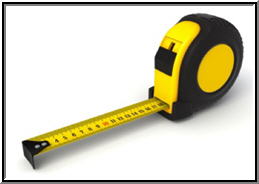How do you measure your risk?
 It’s a question I field frequently, and one which every trader should ask themselves. Sometimes it’s asked in relation to the percentage of portfolio per trade question I discussed last week.
It’s a question I field frequently, and one which every trader should ask themselves. Sometimes it’s asked in relation to the percentage of portfolio per trade question I discussed last week.
Beyond my comments there, there are a few things I consider anytime I’m putting on a new trading position:
Position Size – I do not try to put the same dollar amount into each trade, because for me that does not matter. Two trades can be night and day different from each other in terms of their respective price action and personality.
In the post referenced above, I explained that I have a set $ amount that I’m willing to lose if the trade fails, which is my risk. Position size is then calculated based on that number.
So for ease of example, let’s say I’m willing to lose (risk) $1000 on a trade if I get stopped out for my max loss. Let’s look at 2 trade candidates for a fair comparison…
Trade 1: XYZ with $25 buy point, $24.50 stop (beneath support on chart). There is $0.50/share risk, so I would enter 2000 shares ($50,000 worth of the stock).
Trade 2: ABC with a $25 buy point, $24 stop (beneath support on chart). There is $1/share risk, so I would enter 1000 shares ($25,000 worth of the stock).
So while my actual capital outlay for one trade vs. the next might really differ, I’m keeping my max $ risk constant across trades.
Target setting – The targets for my trades will also vary in terms of absolute $ or %, but they will be pretty consistent when comparing risk/reward. I want to always be putting capital at risk for a defined max loss amount, while still looking to make some multiple of 2-4 times what is being risked if the trade does work out. That’s the case for swing trades and single-day plays alike.
I do put money behind my ideas. What I’m sharing with Bandits in the nightly report is my trading plan for the following day, so these are the actual trades I’m setting up for the following day to make in my own account, not a recommendation for others to take these plays. I don’t decide what’s right for anyone else, I simply share my plan, my levels, and my reasons for the trades I’m making. They’re the best setups I’ve found, so that’s where my capital goes. But a crucial element in that process is measuring my risk and ensuring the trade fits my needs.
Trade Like a Bandit!
Jeff White
Take a trial to my Stock Pick Service to get my trades.












that works great until you get a gap down overnight. instead of getting stopped out for a 50cent loss, you get stopped out for a $ 3 loss. you take a huge hit because you had more shares than you should have held using other stop methods.
Gaps come in both directions, so yes there’s adverse gap risk on any overnight hold, but along with that also comes advantageous gap risk. I have found it evens out over time…sometimes taking a bigger hit than intended, sometimes getting a bigger profit than planned for.
Two other things on this though Frank:
1) it’s earnings season, so staying on top of the calendar and avoiding scheduled news can also help to avoid some of the bigger gaps.
2) only trade in a size you’re comfortable with to begin with.